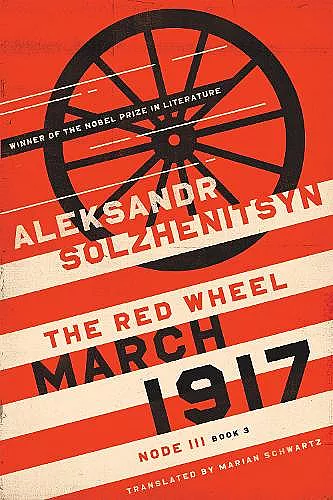March 1917
The Red Wheel, Node III, Book 3
Aleksandr Solzhenitsyn author Marian Schwartz translator
Format:Hardback
Publisher:University of Notre Dame Press
Published:15th Oct '21
Should be back in stock very soon
This hardback is available in another edition too:
- Paperback£24.99(9780268201715)

In March 1917, Book 3 the forces of revolutionary disintegration spread out from Petrograd all the way to the front lines of World War I, presaging Russia’s collapse.
One of the masterpieces of world literature, The Red Wheel is Nobel prize–winner Aleksandr Solzhenitsyn’s multivolume epic work about the Russian Revolution told in the form of a historical novel. March 1917—the third node—tells the story, day by day, of the Russian Revolution itself. Until recently, the final two nodes have been unavailable in English. The publication of Book 1 of March 1917 (in 2017) and Book 2 (in 2019) has begun to rectify this situation.
The action of Book 3 (out of four) is set during March 16–22, 1917. In Book 3, the Romanov dynasty ends and the revolution starts to roll out from Petrograd toward Moscow and the Russian provinces. The dethroned Emperor Nikolai II makes his farewell to the Army and is kept under guard with his family. In Petrograd, the Provisional Government and the Soviet of Workers’ and Soldiers’ Deputies continue to exercise power in parallel. The war hero Lavr Kornilov is appointed military chief of Petrograd. But the Soviet’s “Order No. 1” reaches every soldier, undermining the officer corps and shaking the Army to its foundations. Many officers, including the head of the Baltic Fleet, the progressive Admiral Nepenin, are murdered. Black Sea Fleet Admiral Kolchak holds the revolution at bay; meanwhile, Grand Duke Nikolai Nikolaevich, the emperor’s uncle, makes his way to military headquarters, naïvely thinking he will be allowed to take the Supreme Command.
“Despite its relentless focus on political events, The Red Wheel paradoxically instructs that politics is not the most important thing in life. To the contrary, the main cause of political horror is the overvaluing of politics itself. It is supremely dangerous to presume that if only the right social system could be established, life’s fundamental problems would be resolved. Like the great realist novelists of the nineteenth century, Solzhenitsyn believed that.” —The New York Review of Books
"This is the third book (of four) of March 1917, a ‘node’ of Solzhenitsyn’s historical epic The Red Wheel. Book 3 takes place between March 16 and 22, at the height of the revolution. . . . The translation remains lively and fresh—no small feat, given the sheer size of the novel, the pace at which it shifts among perspectives, and the depth of detail." —Choice
"The best historians and novelists—and Solzhenitsyn was first and foremost a novelist—narrate history through the eyes and ears of the participants who don’t know the outcome of the events they are observing and participating in. In March 1917, Solzhenitsyn presents events through the characters’ perspectives and perceptions at the time, not in hindsight or years afterward." —Asian Review of Books
"Solzhenitsyn relives and recreates how it all happened in Russia in the second decade of the twentieth century, and he does not allow this pivot of world events to be bastardized by the clever hindsight of historians and the comfortable value judgments of our time." —The Spectator
“For most Western historians, the March (February O.S.) Revolution was a glorious, if short-lived, event in the history of an otherwise backward—that is, undemocratic—Russia. Solzhenitsyn did not view it that way. He judged the revolution to have been a catastrophe that prepared the way, within months, for the Bolshevik coup d’état.” —National Review
“Moving from staccato reportage to evocative scenes, the book works as a sort of collage of information, replicating in its stylistic choices the different lenses used to understand history. By combining them into one forceful whole, Solzhenitsyn not only gives us an incredibly vivid sense of the different aspects of the Russian Revolution, but a unique model for how to approach history.” —New York Journal of Books
“Solzhenitsyn’s art in this work conveys deep truths, and opportunities lost, in a way that academic history, increasingly torn between ideology, abstruse methodology, and soulless reductionism, can rarely if ever do. Art, dramatized history, wisdom about statecraft and the art of politics, and a deep, passionate but measured patriotism find elevated expression in the literary art of Aleksandr Solzhenitsyn.” —Law and Liberty
"This is the principal work of the Nobel laureate’s life, to which Solzhenitsyn dedicated several decades and into which poured all his thoughts about the senseless chaos of the modern and postmodern worlds, all told through the prism of that most contingent of events, the Russian Revolution." —The New Criterion
“[A] magisterial depiction of the long, slow collapse of the Tsarist regime in which everybody gets a voice, but nobody feels that he or she can prevent the worst of it. Eerily prescient for the binary confusions of the present.” —VoegelinView
“If Aleksandr Solzhenitsyn’s The Gulag Archipelago presented a mindset-changing view of the history of the USSR, the historical novels that make up his epopee The Red Wheel are a counterweight to the heroics of the October Revolution.” —Russian Review
“Contrary to Tolstoy in War and Peace, Solzhenitsyn means to demonstrate that, at the decisive ‘nodal’ moments of history, the action or inaction of a single individual may have a decisive impact on the course of events.” —National Review
“In The Red Wheel, Aleksandr Solzhenitsyn produced a masterpiece and proved himself a worthy companion of Dostoevsky and rival of Tolstoy.” —Law and Liberty
ISBN: 9780268201708
Dimensions: 234mm x 156mm x 43mm
Weight: unknown
712 pages